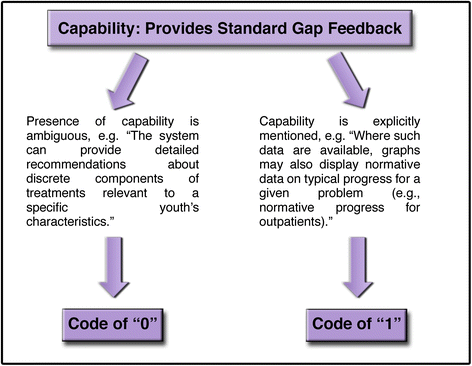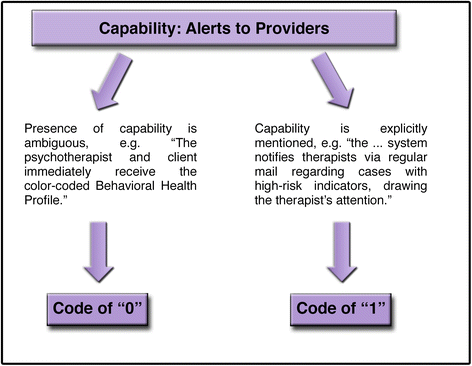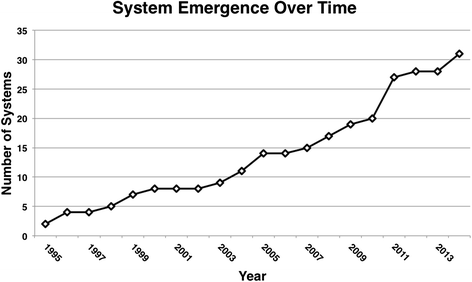Health Information Technologies-Academic and Commercial Evaluation (HIT-ACE) methodology: description and application to clinical feedback systems
- PMID: 27659426
- PMCID: PMC5034443
- DOI: 10.1186/s13012-016-0495-2
Health Information Technologies-Academic and Commercial Evaluation (HIT-ACE) methodology: description and application to clinical feedback systems
Abstract
Background: Health information technologies (HIT) have become nearly ubiquitous in the contemporary healthcare landscape, but information about HIT development, functionality, and implementation readiness is frequently siloed. Theory-driven methods of compiling, evaluating, and integrating information from the academic and commercial sectors are necessary to guide stakeholder decision-making surrounding HIT adoption and to develop pragmatic HIT research agendas. This article presents the Health Information Technologies-Academic and Commercial Evaluation (HIT-ACE) methodology, a structured, theory-driven method for compiling and evaluating information from multiple sectors. As an example demonstration of the methodology, we apply HIT-ACE to mental and behavioral health measurement feedback systems (MFS). MFS are a specific class of HIT that support the implementation of routine outcome monitoring, an evidence-based practice.
Results: HIT-ACE is guided by theories and frameworks related to user-centered design and implementation science. The methodology involves four phases: (1) coding academic and commercial materials, (2) developer/purveyor interviews, (3) linking putative implementation mechanisms to hit capabilities, and (4) experimental testing of capabilities and mechanisms. In the current demonstration, phase 1 included a systematic process to identify MFS in mental and behavioral health using academic literature and commercial websites. Using user-centered design, implementation science, and feedback frameworks, the HIT-ACE coding system was developed, piloted, and used to review each identified system for the presence of 38 capabilities and 18 additional characteristics via a consensus coding process. Bibliometic data were also collected to examine the representation of the systems in the scientific literature. As an example, results are presented for the application of HIT-ACE phase 1 to MFS wherein 49 separate MFS were identified, reflecting a diverse array of characteristics and capabilities.
Conclusions: Preliminary findings demonstrate the utility of HIT-ACE to represent the scope and diversity of a given class of HIT beyond what can be identified in the academic literature. Phase 2 data collection is expected to confirm and expand the information presented and phases 3 and 4 will provide more nuanced information about the impact of specific HIT capabilities. In all, HIT-ACE is expected to support adoption decisions and additional HIT development and implementation research.
Keywords: Behavioral health; Competitive analysis; Health information technology; Measurement feedback systems; Mental health; Routine outcome monitoring.
Figures
Similar articles
-
Capabilities and Characteristics of Digital Measurement Feedback Systems: Results from a Comprehensive Review.Adm Policy Ment Health. 2016 May;43(3):441-66. doi: 10.1007/s10488-016-0719-4. Adm Policy Ment Health. 2016. PMID: 26860952 Free PMC article. Review.
-
User profiles and personas in the design and development of consumer health technologies.Int J Med Inform. 2013 Nov;82(11):e251-68. doi: 10.1016/j.ijmedinf.2011.03.006. Epub 2011 Apr 9. Int J Med Inform. 2013. PMID: 21481635
-
Measurement feedback system implementation in public youth mental health treatment services: a mixed methods analysis.Implement Sci Commun. 2022 Nov 21;3(1):119. doi: 10.1186/s43058-022-00356-5. Implement Sci Commun. 2022. PMID: 36415009 Free PMC article.
-
Student and educator experiences of maternal-child simulation-based learning: a systematic review of qualitative evidence protocol.JBI Database System Rev Implement Rep. 2015 Jan;13(1):14-26. doi: 10.11124/jbisrir-2015-1694. JBI Database System Rev Implement Rep. 2015. PMID: 26447004
-
Outcomes of adoption: measuring evidence uptake by individuals and organizations.Worldviews Evid Based Nurs. 2004;1 Suppl 1:S41-51. doi: 10.1111/j.1524-475X.2004.04048.x. Worldviews Evid Based Nurs. 2004. PMID: 17129334 Review.
Cited by
-
Are We There Yet? Human Factors Knowledge and Health Information Technology - the Challenges of Implementation and Impact.Yearb Med Inform. 2017 Aug;26(1):84-91. doi: 10.15265/IY-2017-014. Epub 2017 Sep 11. Yearb Med Inform. 2017. PMID: 29063542 Free PMC article.
-
Advancing the state-level tracking of evidence-based practices: a case study.Int J Ment Health Syst. 2019 Apr 10;13:25. doi: 10.1186/s13033-019-0280-0. eCollection 2019. Int J Ment Health Syst. 2019. PMID: 31007712 Free PMC article.
-
Dynamics behind the scale up of evidence-based obesity prevention: protocol for a multi-site case study of an electronic implementation monitoring system in health promotion practice.Implement Sci. 2017 Dec 6;12(1):146. doi: 10.1186/s13012-017-0686-5. Implement Sci. 2017. PMID: 29208000 Free PMC article.
-
Will E-Monitoring of Policy and Program Implementation Stifle or Enhance Practice? How Would We Know?Front Public Health. 2018 Sep 11;6:243. doi: 10.3389/fpubh.2018.00243. eCollection 2018. Front Public Health. 2018. PMID: 30258836 Free PMC article. Review.
-
Impact of a Web-Based Electronic Health Record on Behavioral Health Service Delivery for Children and Adolescents: Randomized Controlled Trial.J Med Internet Res. 2018 Jun 14;20(6):e10197. doi: 10.2196/10197. J Med Internet Res. 2018. PMID: 29903701 Free PMC article. Clinical Trial.
References
-
- Dimitropoulos L. Health IT research priorities to support the health care delivery system of the future. Rockv MD Agency Healthc Res Qual. 2014. https://healthit.ahrq.gov/sites/default/files/docs/citation/health-it-re....
-
- Patient Protection and Affordable Care Act. 2010
-
- Health information technology for economic and clinical health act. 2009
-
- Calisir F, Calisir F. The relation of interface usability characteristics, perceived usefulness, and perceived ease of use to end-user satisfaction with enterprise resource planning (ERP) systems. Comput Hum Behav. 2004;20:505–515. doi: 10.1016/j.chb.2003.10.004. - DOI
Grants and funding
LinkOut - more resources
Full Text Sources
Other Literature Sources
Research Materials
Miscellaneous





